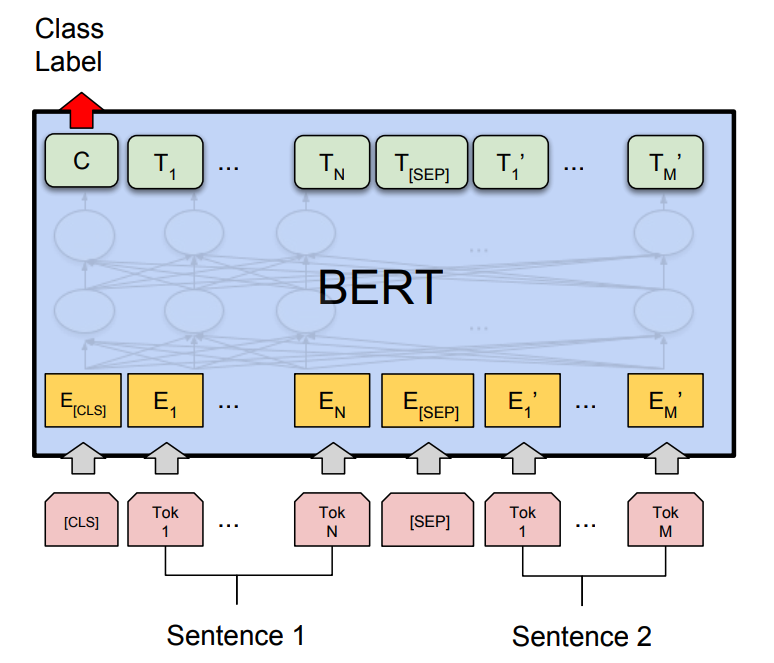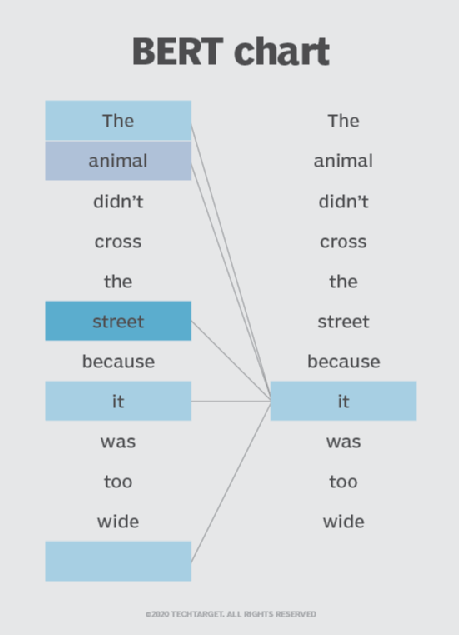BERT is an open source machine learning framework for natural language processing (NLP). BERT is designed to help computers understand the meaning of ambiguous language in text by using surrounding text to establish context. The BERT framework was pre-trained using text from Wikipedia and can be fine-tuned with question and answer datasets.
BERT, which stands for Bidirectional Encoder Representations from Transformers, is based on Transformers, a deep learning model in which every output element is connected to every input element, and the weightings between them are dynamically calculated based upon their connection. (In NLP, this process is called attention.)
Historically, language models could only read text input sequentially -- either left-to-right or right-to-left -- but couldn't do both at the same time. BERT is different because it is designed to read in both directions at once. This capability, enabled by the introduction of Transformers, is known as bidirectionality.
Using this bidirectional capability, BERT is pre-trained on two different, but related, NLP tasks: Masked Language Modeling and Next Sentence Prediction.
The objective of Masked Language Model (MLM) training is to hide a word in a sentence and then have the program predict what word has been hidden (masked) based on the hidden word's context. The objective of Next Sentence Prediction training is to have the program predict whether two given sentences have a logical, sequential connection or whether their relationship is simply random.
How BERT works
The goal of any given NLP technique is to understand human language as it is spoken naturally. In BERT's case, this typically means predicting a word in a blank. To do this, models typically need to train using a large repository of specialized, labeled training data.
BERT, however, was pre-trained using only an unlabeled, plain text corpus (namely the entirety of the English Wikipedia, and the Brown Corpus). It continues to learn unsupervised from the unlabeled text and improve even as its being used in practical applications (ie Google search). Its pre-training serves as a base layer of "knowledge" to build from. From there, BERT can adapt to the ever-growing body of searchable content and queries and be fine-tuned to a user's specifications. This process is known as transfer learning.
As mentioned above, BERT is made possible by Google's research on Transformers. The transformer is the part of the model that gives BERT its increased capacity for understanding context and ambiguity in language. The transformer does this by processing any given word in relation to all other words in a sentence, rather than processing them one at a time. By looking at all surrounding words, the Transformer allows the BERT model to understand the full context of the word, and therefore better understand searcher intent.
This is contrasted against the traditional method of language processing, known as word embedding, in which previous models like GloVe and word2vec would map every single word to a vector, which represents only one dimension, a sliver, of that word's meaning.
These word embedding models require large datasets of labeled data. While they are adept at many general NLP tasks, they fail at the context-heavy, predictive nature of question answering, because all words are in some sense fixed to a vector or meaning. BERT uses a method of masked language modeling to keep the word in focus from "seeing itself" -- that is, having a fixed meaning independent of its context. BERT is then forced to identify the masked word based on context alone. In BERT words are defined by their surroundings, not by a pre-fixed identity. In the words of English linguist John Rupert Firth, "You shall know a word by the company it keeps."

BERT is also the first NLP technique to rely solely on self-attention mechanism, which is made possible by the bidirectional Transformers at the center of BERT's design. This is significant because often, a word may change meaning as a sentence develops. Each word added augments the overall meaning of the word being focused on by the NLP algorithm. The more words that are present in total in each sentence or phrase, the more ambiguous the word in focus becomes. BERT accounts for the augmented meaning by reading bidirectionally, accounting for the effect of all other words in a sentence on the focus word and eliminating the left-to-right momentum that biases words towards a certain meaning as a sentence progresses.
- Question answering
- Abstract summarization
- Sentence prediction
- Conversational response generation
- Polysemy and Coreference (words that sound or look the same but have different meanings) resolution
- Word sense disambiguation
- Natural language inference
- Sentiment classification
- patentBERT - a BERT model fine-tuned to perform patent classification.
- docBERT - a BERT model fine-tuned for document classification.
- bioBERT - a pre-trained biomedical language representation model for biomedical text mining.
- VideoBERT - a joint visual-linguistic model for process unsupervised learning of an abundance of unlabeled data on Youtube.
- SciBERT - a pretrained BERT model for scientific text
- G-BERT - a BERT model pretrained using medical codes with hierarchical representations using graph neural networks (GNN) and then fine-tuned for making medical recommendations.
- TinyBERT by Huawei - a smaller, "student" BERT that learns from the original "teacher" BERT, performing transformer distillation to improve efficiency. TinyBERT produced promising results in comparison to BERT-base while being 7.5 times smaller and 9.4 times faster at inference.
- DistilBERT by HuggingFace - a supposedly smaller, faster, cheaper version of BERT that is trained from BERT, and then certain architectural aspects are removed for the sake of efficiency.
- Classification tasks such as sentiment analysis are done similarly to Next Sentence classification, by adding a classification layer on top of the Transformer output for the [CLS] token.
- In Question Answering tasks (e.g. SQuAD v1.1), the software receives a question regarding a text sequence and is required to mark the answer in the sequence. Using BERT, a Q&A model can be trained by learning two extra vectors that mark the beginning and the end of the answer.
- In Named Entity Recognition (NER), the software receives a text sequence and is required to mark the various types of entities (Person, Organization, Date, etc) that appear in the text. Using BERT, a NER model can be trained by feeding the output vector of each token into a classification layer that predicts the NER label.
- Model size matters, even at huge scale. BERT_large, with 345 million parameters, is the largest model of its kind. It is demonstrably superior on small-scale tasks to BERT_base, which uses the same architecture with “only” 110 million parameters.
- With enough training data, more training steps == higher accuracy. For instance, on the MNLI task, the BERT_base accuracy improves by 1.0% when trained on 1M steps (128,000 words batch size) compared to 500K steps with the same batch size.
- BERT’s bidirectional approach (MLM) converges slower than left-to-right approaches (because only 15% of words are predicted in each batch) but bidirectional training still outperforms left-to-right training after a small number of pre-training steps.
Bert source code: https://github.com/google-research/bert
Article source: techtarget.com
***Thank You***


0 Response to "Bidirectional Encoder Representations from Transformers (BERT)"
Post a Comment